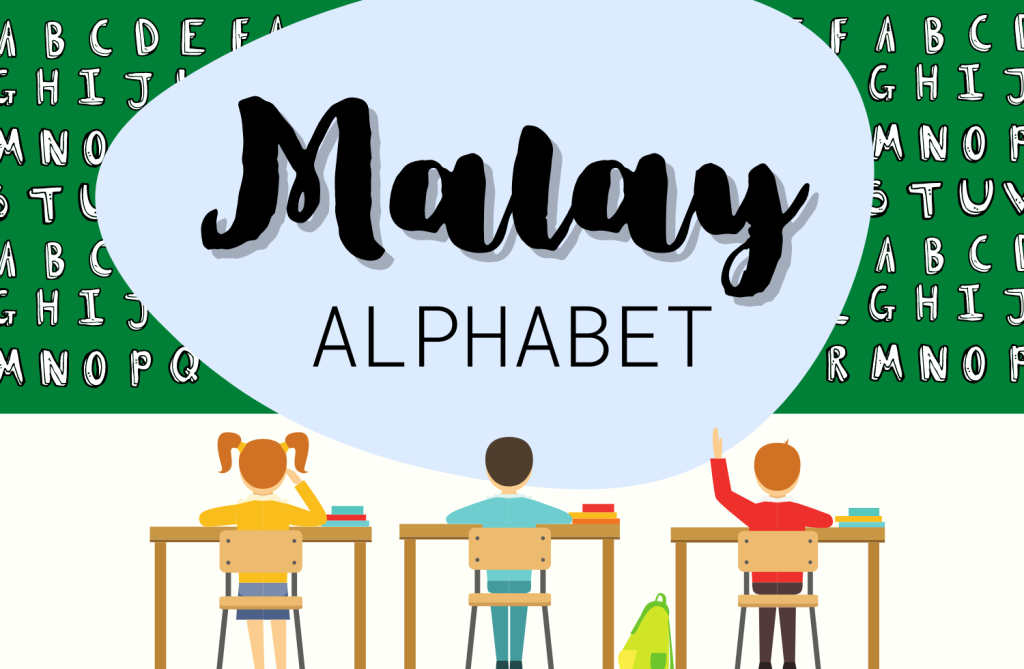Alphabet is the first thing you learn in the journey of acquiring your first language, apart from naturally inheriting the spoken aspect of the language from your parents. Today, we’ll look at the alphabet and letters in Bahasa Melayu.
The Story Behind Malay Alphabet

Initially, Bahasa Melayu was written in Arabic scripts, known as tulisan jawi to Malay native speakers. However, as Malaysia is one of the countries colonized by the British, the Latin alphabet was introduced and later on used in the Malay writing system, which lasts up until today. In Malay, this writing is called tulisan rumi (Roman writing). This Latin Malay alphabet (26 letters with no diacritics) is the official Malay script in Malaysia (and also some of its neighboring countries like Indonesia and Singapore). Brunei uses it too but it’s not their official writing script.
Malay Alphabet
If you’re an English speaker, either native or non-native, then this will definitely be a piece of cake. The Malay language uses the exact alphabets you use in the English language. So, if anyone asks do you know the Malay alphabet, the answer is yes! You already do! (This also proves how easy it is to learn Malay! – there’s no need for you to learn new writing scripts and letters!)
Let’s see the letters along with their examples and pronunciation tips.
1) Aa
Like English and the Indonesian language, the Malaysian language starts with the letter A. It sounds like the English equivalent /a/, as in the vocal ‘a’ in the word father.
2) Bb
The pronunciation of B is exactly the same as how it’s articulated in English, with the /b/ phoneme in ball, beast, and bow.
3) Cc
In English, normally words with C are pronounced with a /k/ sound but such is not the case in Bahasa Melayu. In Malay, C makes the /ʧ/ (ch) sound, like the ones in the English words charge, check and change.
4) Dd
This one is pronounced exactly like how you pronounced the English /d/ sounds; day, island, and dad.
5) Ee
In Bahasa Melayu, you’ll hear the locals say emas (gold), betik (papaya), and telur (egg) – the E in all these sounds exactly like the one in the English word the, with the /ə/ as its phonetic transcription.
There’s also another E you’ll hear being spoken in Malay, which is E /ɛ/ in ekor (tail), epal (apple), and elak (avoid). This version of E sounds like the initial vowel in the English word elephant /ɛləfənt/.
6) Ff
As Malay is straightforward, F sounds /f/, like how the consonant is articulated in the photo (foʊˌtoʊ), food (fud), and tough (tʌf).
7) Gg
The consonant G is always enunciated with the /g/ phoneme like in good, get and gas.
8) Hh
In English, there’s such a thing as a silent H but there is none in Bahasa Melayu. The H is articulated clearly, like how you say hairy, hot, and hammer.
9) Ii
In Bahasa Melayu, I sound like the vowels in meat /mit/. Sometimes, to make things easier, the local teachers transcribe the /i/ phoneme to -ee for foreign students in their lessons, especially to English native speakers. For instance, to say the word hari (day), local teachers would transcribe the pronunciation to HAR-EE, just so the native English speakers are able to enunciate the vowel correctly.
10) Jj
This one is quite straightforward too. J sounds exactly like how you’d say joker, jug, and judge. It produces that /ʤ/ sound.
11) Kk
This one sounds /k/ in the Bahasa Melayu vocabulary. It’s identical to how you would enunciate cold, cat, and car.
12) Ll
/l/ as in how it sounds in English; long, live, and love.
13) Mm
The M in Bahasa Melayu is identical to how you usually utter mother, mumble, or man.
14) Nn
The Malaysians say the /n/ vocabulary exactly like how you say the N consonant in nice, now, and on.
15) Oo
O when transcripted into its phonetic transcription, it becomes /oʊ/. In Bahasa Melayu, the O vowel is articulated like owe, low, and bow.
16) Pp
Some of the vocabulary with the P consonants in Bahasa Melayu are pipi, petang, and pagi. It sounds exactly like pan, paper, and pin.
17) Qq
Like English, the Q in Bahasa Melayu is articulated as /k/. It’s similar to when you say queen, quality, and quick.
18) Rr
The R consonants in rumah (house) and ruang (space) is articulated with /r/ phoneme, like how you say rice, rat, and brick.
19) Ss
Satu, which means number one in Bahasa Melayu in articulated as /sɑtu/. Clearly, based on this example, the S consonant sounds the same as the ones in sand, soap, and bus.
20) Tt
T is also precisely uttered as in how you typically say table, text, and write.
21) Uu
From the previous letters, you can see how most sounds are identical to English but this one, in particular, is not. U, if transcribed to English, equates to the -oo in the word ‘loop’ /lup/. It sounds just like the vowels in coop, boot, and loot.
22) Vv
This consonant also sounds entirely like how you’d pronounce vain, venture, and vine.
23) Ww
W creates the /w/ phoneme, which links to how you usually heard people say wow, win and winter.
24) Xx
This is truly the trickiest letter to pronounce, which why its pronunciation is as to how it’s done in English. Though an X, it sounds just like a Z, as the phonetic transcription of the xylophone is /zaɪləˌfoʊn/.
25) Yy
How do you pronounce yummy, yam, and day? That’s precisely how Y sounds in Bahasa Melayu as well.
26) Zz
Z sounds exactly like how you pronounce zebra, zap, and zeal.
Examples Of Malay Vocabulary
| ALPHABET | MALAY | ENGLISH | PHONETIC TRANSCRIPTION | TRANSLITERATION |
| Aa | Ayam | Chicken | /ɑˈjʌm/ | A-yum |
| Bb | Bola | ball | /bolɑ/ | BO-la |
| Cc | Cawan | cup | /ʧɑwʌn/ | Cha-one |
| Dd | Dagu | chin | /dagu/ | DA-goo |
| Ee | Elak Emas |
avoid gold |
/ˈɛlʌk/ /əmʌs/ |
ei-luck ə-must (without /t/ sound!) |
| Ff | Fail | file | /faɪl/ | file |
| Gg | Gam | glue | /gʌm/ | gum |
| Hh | Hari | day | /hʌri/ | HA-ri |
| Ii | Ikan | fish | /ɪkʌn/ | ee-kʌn |
| Jj | Jari | finger | /ʤɑrɪ/ | JAr-i |
| Kk | Kamu | you | /kɑmu/ | Car-moo |
| Ll | Lima | five | /limɑ/ | lee-ma |
| Mm | Makan | eat | /mɑkʌn/ | Ma-kʌn |
| Nn | Nasi | rice | /nɑsi/ | Na-see |
| Oo | Otak | brain | /oʊtʌk/ | O-tuck |
| Pp | Pagi | morning | /pʌgi/ | PA-gi |
| Qari | reciter | /kɔri/ | KOR-i | |
| Rr | Rumah | house | /rumɑh/ | room-AH |
| Ss | Satu | one | /sɑtu/ | sɑ-too |
| Tt | Taman | park | /tɑmʌn/ | ta-mʌn |
| Uu | Udang | shrimp | /udɑŋ/ | oo-dang |
| Vv | Van | caravan | /væn/ | van |
| Ww | Wau | moon-shaped kite | /waʊ/ | wow |
| Xx | Xilofon | xylophone | /zɪloˌfoʊn/ | zee-lo-phone |
| Yy | Yoyo | yoyo | /joʊjoʊ/ | yow-yow |
| Zz | Zip | zip fastener | /zɪp/ | zip |
Interested To Know More About Bahasa Melayu?
So, if you’re wondering what’s the best way to acquire Bahasa Melayu (or any other languages), try Ling App. This app can teach you all the common phrases, expressions, vocabulary, terms, numbers, grammar and so much more through its interactive lessons. Being on this app will make you stay put because Ling’s content is gamified, just to make your eyes and brains glued to the interesting lessons. Try Ling App today.










